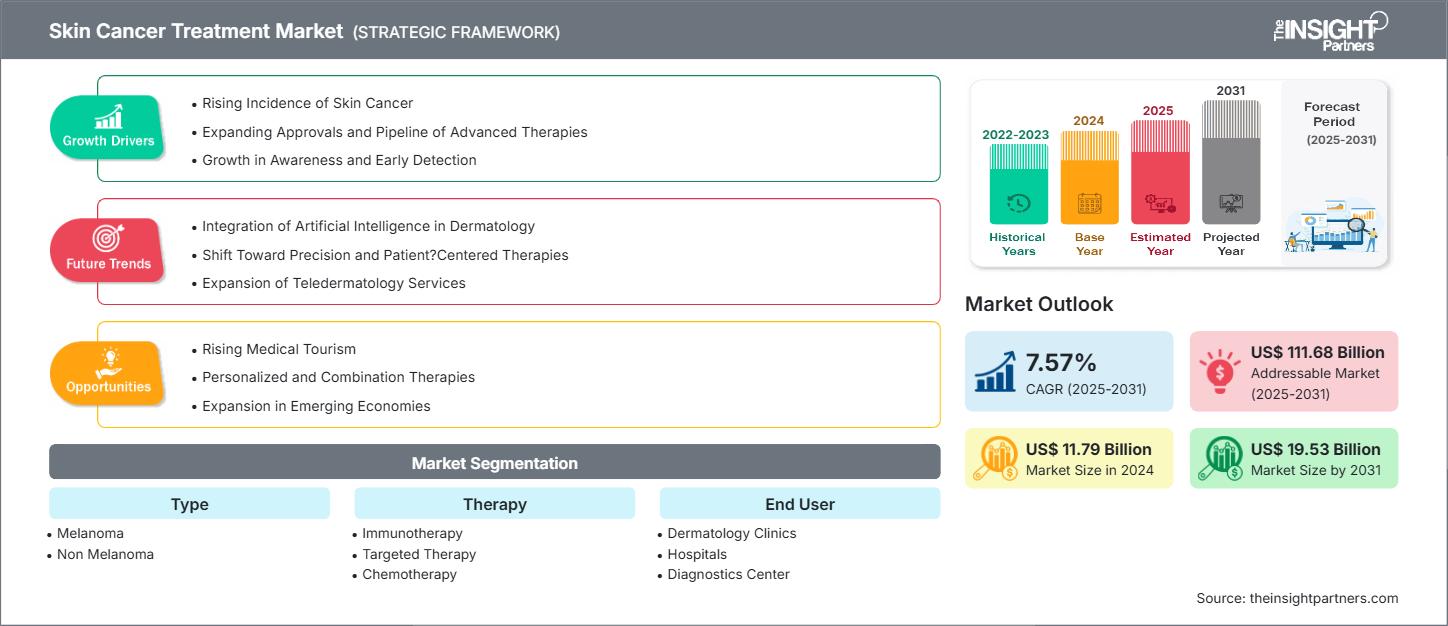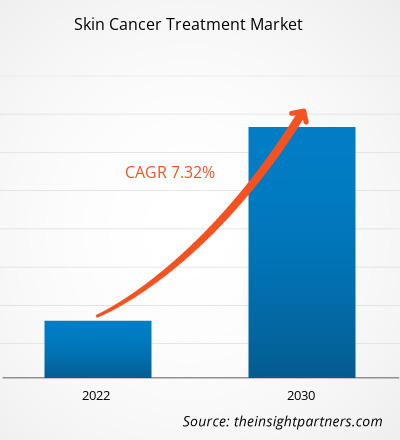피부암 치료 시장 규모는 2024년 117억 9천만 달러에서 2031년 195억 3천만 달러로 성장할 것으로 예상됩니다. 이 시장은 2025년부터 2031년까지 7.57%의 CAGR을 기록할 것으로 예상됩니다.
피부암 치료 시장 분석
피부암 유병률 급증, 승인 증가, 그리고 첨단 치료법의 탄탄한 파이프라인은 피부암 치료의 사용을 촉진하고 있습니다. 미국 암 학회에 따르면 2025년 미국에서 약 212,200건의 신규 흑색종 사례가 발생했으며, 이 중 107,240건은 상피내암, 104,960건은 침습적 암으로, 흑색종은 5번째로 흔한 암입니다. 흑색종을 비롯한 피부암의 발병률 증가는 면역관문 억제제와 같은 첨단 치료법에 대한 수요를 창출했습니다. 또한, 개인 맞춤형 및 복합 치료법의 도입은 피부암 치료 시장에 중요한 기회를 제공합니다.
피부암 치료 시장 개요
북미 지역이 피부암 치료 시장에서 가장 큰 점유율을 차지할 것으로 예상되며, 아시아 태평양 지역은 예측 기간 동안 상당한 연평균 성장률(CAGR)을 기록할 것으로 예상됩니다. 이 지역에는 중국, 일본, 인도, 한국, 호주와 같은 주요 시장과 더 나아가 아시아 태평양 지역이 포함되며, 지역 성장에서 상당한 비중을 차지합니다. 일부 아시아 국가의 피부암 발생률은 서구 국가보다 낮은데, 이는 인구의 멜라닌 구성이 더 좋기 때문일 수 있습니다. 중국 국가암센터의 2024년 보고서에 따르면 기저세포암과 편평세포암의 발생률이 증가하고 있으며, 특히 푸젠성과 광둥성 같은 해안 지역에서 증가하고 있습니다.
호주 보건복지연구소(AIHW)는 2023년에 110만 명이 넘는 호주인이 메디케어 혜택 일정(MBS)에 따라 비흑색종 피부암 치료를 받았다고 보고했습니다. 같은 보고서는 흑색종으로 인해 2022년에 약 15,000건의 신규 발병 사례와 1,300명 이상의 사망자가 발생했다고 언급했습니다.
국립암센터에 따르면 일본에서 흑색종 발병률이 꾸준히 증가하고 있으며, 특히 고령층에서 증가하고 있습니다. 2024년 암 등록 최신 자료에 따르면, 피부암은 일본에서 가장 흔한 암 20위 안에 들며, 특히 60세 이상 남성에서 발병률이 증가하는 추세입니다.
이 보고서의 일부 또는 국가 수준 분석, Excel 데이터 팩을 포함하여 모든 보고서에 대한 사용자 정의를 무료로 받을 수 있으며, 신생 기업 및 대학을 위한 훌륭한 혜택과 할인도 이용할 수 있습니다.
피부암 치료 시장: 전략적 통찰력

-
이 보고서에서 주요 시장 동향을 알아보세요.이 무료 샘플에는 시장 동향부터 추정치 및 예측까지 다양한 데이터 분석이 포함됩니다.
피부암 치료 시장 동인 및 기회
시장 동인:
-
첨단 치료제 승인 및 파이프라인 확대:
승인 확대와 새로운 면역 요법 및 표적 치료 옵션을 포함한 첨단 치료법의 강력한 파이프라인은 진행성 또는 공격적인 피부암 환자에게 더 많은 선택권을 제공합니다.immunotherapy and targeted therapy options, provide more choices for patients with advanced or aggressive skin cancer. -
피부암 유병률 증가:
흑색종 및 비흑색종 피부암 환자 증가는 피부암 치료 시장의 성장을 촉진하고 있습니다. 피부암 환자 수의 꾸준한 증가는 시장 성장과 다각화를 촉진하는 주요 요인 중 하나가 되고 있습니다.nonmelanoma skin cancer cases is fueling the growth of the skin cancer treatment market. This steady growth of skin cancer cases is becoming one of the primary factors steering the growth and diversification of the market. -
조기 발견에 대한 인식 증가:
피부암, 특히 흑색종은 조기에 발견하면 치료 효과가 매우 높습니다. 조기에 발견하면 수술적 절제와 같은 덜 침습적이고 효과적인 치료법을 사용할 수 있습니다.
시장 기회:
-
신흥 경제권 확장: 아시아 태평양, 라틴 아메리카, 아프리카의 여러 국가는 피부암 발병 건수 증가와 조기 발견에 대한 인식으로 인해 피부암 치료 시장에서 성장 기회를 제공합니다.
. -
의료 관광의 증가:
중국, 인도, 인도네시아, 브라질, 멕시코 등 개발도상국의 의료 관광이 늘어나면서 저렴한 첨단 치료와 시술을 받을 수 있으며, 이는 미국과 유럽 국가보다 50~70% 저렴합니다. -
개인맞춤 및 복합치료:
공공 의료 제도에 따라 자금이 지원되는 신보조 면역 요법(수술 전)과 같은 첨단 치료법은 고위험 환자의 생존 결과를 극적으로 개선할 수 있습니다.
피부암 치료 시장 보고서 세분화 분석
피부암 치료 시장은 그 작용 원리, 성장 잠재력, 그리고 최신 트렌드를 더욱 명확하게 보여주기 위해 여러 부문으로 구분됩니다. 대부분의 업계 보고서에서 사용되는 표준 세분화 방식은 다음과 같습니다.
유형별:
-
흑색종:
흑색종은 유형별로 두 번째로 큰 부분을 차지하며, 전 세계적으로 흑색종 발병률이 증가하는 추세에 크게 기여하고 있습니다. WHO는 2022년 전 세계적으로 매년 약 33만 건의 새로운 흑색종 피부암 사례가 발생한다고 보고했습니다. -
비흑색종:
비흑색종 피부암은 흑색종 피부암보다 더 흔합니다. 비흑색종은 메르켈 세포암, 기저세포암, 편평세포암을 포함합니다. 이러한 암은 수술로 완치가 가능하며 치명률은 매우 낮습니다.
치료 유형별:
-
면역요법:
임상 데이터에 따르면 페므브롤리주맙과 같은 면역 요법은 진행성 흑색종 환자에게 5년 전체 생존율을 약 34%로 높이는 것으로 나타났으며, 이는 기존 방법에 비해 괄목할 만한 개선입니다. -
표적 치료:
표적 치료는 기존 화학 요법보다 한 단계 발전된 방식으로, 암세포 성장을 담당하는 특정 분자 경로를 공격합니다. 가장 획기적인 성공 사례는 흑색종 환자의 약 40~60%에서 발견되는 BRAF 유전자 돌연변이의 발견입니다. -
화학요법:
화학요법의 주요 목표는 세포에 독성이 있는 약물을 사용하여 빠르게 분열하는 암세포를 제거하는 것입니다. 그러나 표적 치료와 달리 화학요법은 건강한 세포와 암세포를 구분하지 않습니다. 따라서 화학요법은 여러 가지 부작용을 동반합니다. -
방사선 요법:
피부암의 경우, 수술이나 전신 치료를 받을 수 없는 환자는 방사선 치료의 혜택을 누릴 수 있습니다. 진행성 또는 수술이 불가능한 종양의 경우, 방사선 치료는 통증, 출혈, 폐색과 같은 증상을 완화하는 데에도 효과적입니다. -
기타:
이 외에도 네오프렌이나 폴리이소프렌과 같은 다른 소재도 있습니다. 네오프렌은 수술용 장갑 제작에 널리 사용되며, 뛰어난 보호력과 적절한 착용감, 그리고 편안한 착용감을 제공합니다.
최종 사용자별:
- 피부과 클리닉
- 병원
- 진단 및 암 치료 센터
- 기타
지리별:
- 북아메리카
- 유럽
- 아시아 태평양
- 라틴 아메리카
- 중동 및 아프리카
북미 피부암 치료 시장은 상당한 시장 점유율을 차지할 것으로 예상됩니다. 수술 시술 건수 증가와 시장 참여자들의 사업 확장 전략이 시장 성장을 견인할 것으로 예상됩니다.
피부암 치료 시장 지역별 통찰력
The Insight Partners의 분석가들은 예측 기간 동안 피부암 치료 시장에 영향을 미치는 지역별 동향과 요인을 면밀히 분석했습니다. 이 섹션에서는 북미, 유럽, 아시아 태평양, 중동 및 아프리카, 그리고 중남미 지역의 피부암 치료 시장 부문 및 지역별 현황도 살펴봅니다.
피부암 치료 시장 보고서 범위
| 보고서 속성 | 세부 |
|---|---|
| 2024년 시장 규모 | 117억 9천만 달러 |
| 2031년까지 시장 규모 | 195억 3천만 달러 |
| 글로벌 CAGR(2025~2031년) | 7.57% |
| 역사적 데이터 | 2022-2023 |
| 예측 기간 | 2025-2031 |
| 다루는 세그먼트 |
유형별
|
| 포함된 지역 및 국가 |
북아메리카
|
| 시장 선도 기업 및 주요 회사 프로필 |
|
피부암 치료 시장 참여자 밀도: 비즈니스 역학에 미치는 영향 이해
피부암 치료 시장은 소비자 선호도 변화, 기술 발전, 그리고 제품 효능에 대한 인식 제고 등의 요인으로 인한 최종 사용자 수요 증가에 힘입어 빠르게 성장하고 있습니다. 수요가 증가함에 따라 기업들은 제품 라인업을 확장하고, 소비자 니즈를 충족하기 위한 혁신을 추진하며, 새로운 트렌드를 적극 활용하고 있으며, 이는 시장 성장을 더욱 가속화하고 있습니다.

- 피부암 치료 시장의 주요 기업 개요를 알아보세요
지역별 피부암 치료 시장 점유율 분석
아시아 태평양 지역은 향후 몇 년 동안 가장 빠른 성장을 보일 것으로 예상됩니다. 라틴 아메리카, 중동, 아프리카의 신흥 시장 또한 피부암 치료 업체들이 확장할 수 있는 많은 미개척 기회를 보유하고 있습니다.
피부암 치료 시장은 지역마다 성장 양상이 다릅니다. 만성 질환 유병률 증가, 수술 시술 증가, 감염 관리 전략 도입 증가 등의 요인 때문입니다. 아래는 지역별 시장 점유율 및 동향을 요약한 것입니다.
1. 북미
-
시장 점유율:
글로벌 시장의 상당 부분을 차지합니다 -
주요 동인:
- 특정 부위에 과도한 자외선 노출로 인해 흑색종 및 기타 피부암의 발생률이 높습니다.
- 면역요법과 표적치료를 포함한 잘 발달된 치료 옵션이 존재합니다.
- 높은 의료비 지출과 체계적인 보상 체계도 주목할 만합니다.
-
트렌드:
개인화된 의료의 사용이 증가하고, 새로운 생물학 및 치료법에 대한 개발과 많은 투자가 이루어지고, 새로운 약물 발견을 위한 자금이 풍부합니다.
2. 유럽
-
시장 점유율:
시장의 상당 부분은 첨단 의료와 새로운 치료법의 빠른 도입에 기인합니다. -
주요 동인:
- 비흑색종 및 흑색종 피부암 환자의 수가 증가하고 있습니다.
- 암 인식 및 검진 프로그램에 대한 정부의 호의적인 정책.
- 첨단 방사선 치료 기술과 임상 시험 네트워크의 가용성.
-
트렌드:
정밀 종양학, 복합 치료 접근법(면역 치료 + 표적 치료), 피부과 진단에 AI 통합에 집중
3. 아시아 태평양
-
시장 점유율:
매년 시장 점유율이 증가하는 가장 빠르게 성장하는 지역 -
주요 동인:
- 중국, 인도, 동남아시아 전역에서 의료 인프라가 빠르게 개선되었습니다.
- 야외 노출 증가와 보호 조치의 제한으로 인해 환자 인구가 증가하고 있습니다.
- 암 치료에 대한 정부 자금 지원을 늘리고 보험 적용 범위를 확대합니다.
-
트렌드:
저렴한 암 치료를 위한 의료 여행 증가, 최신 진단 영상 도구 활용, 국제 제약 회사와의 협력 증가.
4. 남미 및 중미
-
시장 점유율:
꾸준한 성장을 보이는 개발 시장. -
주요 동인:
- 특히 브라질과 칠레와 같이 자외선 지수가 높은 지역에서 피부암 발생률이 증가하고 있습니다.
- 피부과 전문의와 암 치료 센터에 대한 접근성 확대.
- 첨단 피부암 치료제 및 장비 수입.
-
트렌드:
인식 캠페인에 대한 집중 강화, 저렴한 치료를 위한 의료 관광, 면역 요법의 지역 시장 진출 점진적 확대.
5. 중동 및 아프리카
-
시장 점유율:
작지만 빠르게 성장하고 있습니다 -
주요 동인:
- 정부 자금 지원을 받아 의료 인프라를 확대합니다.
- 암 예방 및 조기 발견에 대한 인식 제고 캠페인이 확대됩니다.
- 임상 시험 확대를 위해 글로벌 제약 회사와의 협력을 확대합니다.
-
트렌드:
피부암 예방을 위한 정부 지원 이니셔티브, 첨단 종양학 센터에 대한 투자, 원격 진단을 위한 원격 피부과 사용 확대.
피부암 치료 시장 참여자 밀도: 비즈니스에 미치는 영향 이해: 높은 경쟁과 시장 밀도
높은 시장 밀도와 경쟁
사노피, 아스트라제네카, 일라이 릴리 등 기존 제약사들 간의 경쟁이 치열합니다. Sun Pharmaceutical Industries Ltd(아시아 태평양)와 Takeda Pharmaceutical(아시아 태평양)과 같은 지역 및 틈새 시장 업체들 또한 여러 지역의 경쟁 구도를 더욱 심화시키고 있습니다.
이러한 높은 수준의 경쟁으로 인해 기업은 다음과 같은 서비스를 제공하여 두각을 나타내야 합니다.
- 고급 제품
- 맞춤형 서비스 및 지속 가능한 솔루션과 같은 부가가치 서비스
- 경쟁력 있는 가격 모델
- 규제 지침 준수
기회와 전략적 움직임
- 새로운 복합 치료법을 개발하고 임상적으로 조사하는 데 중점을 두고 있습니다.
-
기업들은 회복 시간과 부작용을 줄이는 국소 및 광역학 치료와 같은 비침습적 치료법으로 전환하고 있습니다.
- 기존 기업들은 바이오기술 기업, 학술 연구 기관, 의료 서비스 제공업체와 협력하여 치료법 개발과 임상 도입을 가속화합니다.
피부암 치료 시장에서 활동하는 주요 회사는 다음과 같습니다.
- 머크 KGaA
- 화이자 주식회사
- 노바티스 AG
- 브리스톨-마이어스 스퀴브 주식회사
- 암젠 주식회사
- 호프만-라 로슈 유한회사
- 리제네론 파마슈티컬스 주식회사
- GSK 주식회사
- 이오반스 바이오테라퓨틱스 주식회사
- 제넨텍 주식회사
면책 조항: 위 회사는 순위대로 나열된 것이 아닙니다.
연구 과정에서 분석된 다른 회사:
- 사노피
- 선제약산업주식회사
- 엘리 릴리 앤 컴퍼니
- 아스트라제네카 PLC
- 다케다 제약 주식회사
- 입센파마
- 배리안 메디컬 시스템 주식회사
- 교와기린 주식회사
- 엘렉타 AB
- 아쿠아제약
- 주식회사 아이캐드
- AB 과학
- 셀슈틱스 코퍼레이션
- 에자이 주식회사
- 오츠카제약 주식회사
피부암 치료 시장 뉴스 및 최근 동향
- 미국 식품의약국(FDA)은 완전 절제된 2IB기 또는 2IC기 흑색종이 있는 적격 환자의 보조 치료제로 오디보(니볼루맙)를 승인했습니다.
- 노바티스는 에라스카와 2,000만 달러 규모의 라이선스 계약을 체결해 나포라페닙 흑색종 치료제를 중간 단계 개발로 전환했습니다.
피부암 치료 시장 보고서 범위 및 성과물
"피부암 치료 시장 규모 및 예측(2021~2031)" 보고서는 아래 영역을 포괄하여 시장에 대한 자세한 분석을 제공합니다.
- 범위에 포함된 모든 주요 시장 부문에 대한 글로벌, 지역 및 국가 수준의 피부암 치료 시장 규모 및 예측
- 피부암 치료 시장 동향 및 동인, 제약 및 주요 기회와 같은 시장 역학
- 자세한 PEST 및 SWOT 분석
- 주요 시장 동향, 글로벌 및 지역 프레임워크, 주요 참여자, 규정 및 최근 시장 개발을 다루는 피부암 치료 시장 분석
- 피부암 치료 시장의 시장 집중도, 히트맵 분석, 주요 업체 및 최근 개발 사항을 다루는 산업 환경 및 경쟁 분석
- 자세한 회사 프로필
- 과거 분석(2년), 기준 연도, CAGR을 포함한 예측(7년)
- PEST 및 SWOT 분석
- 시장 규모 가치/거래량 - 글로벌, 지역, 국가
- 산업 및 경쟁 환경
- Excel 데이터세트
최근 보고서
관련 보고서
사용 후기
구매 이유
- 정보에 기반한 의사 결정
- 시장 역학 이해
- 경쟁 분석
- 고객 인사이트
- 시장 예측
- 위험 완화
- 전략 기획
- 투자 타당성 분석
- 신흥 시장 파악
- 마케팅 전략 강화
- 운영 효율성 향상
- 규제 동향에 발맞춰 대응






















 무료 샘플 받기 - 피부암 치료 시장
무료 샘플 받기 - 피부암 치료 시장